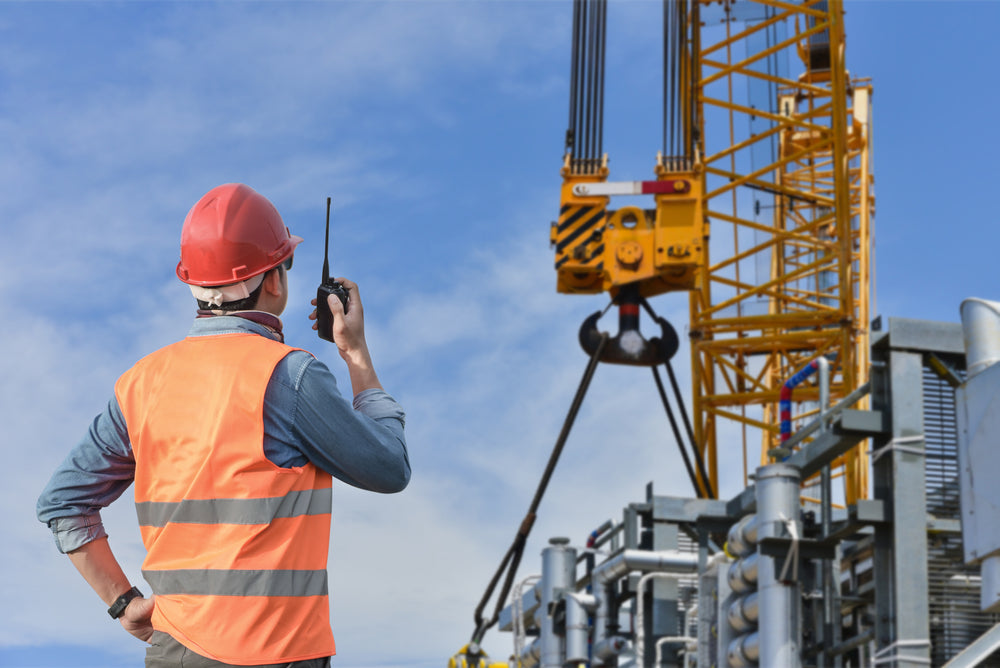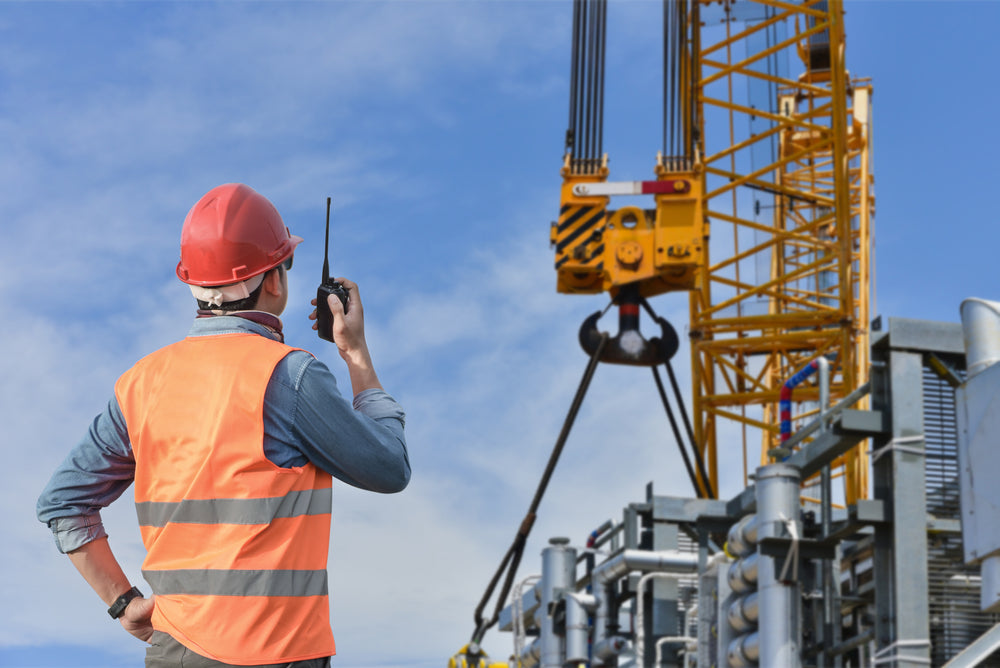TLILIC0024 Licence to Operate a Vehicle Loading Crane (capacity 10 metre tonnes and above) - Ingleburn, Sydney

TLILIC0024 Licence to Operate a Vehicle Loading Crane (capacity 10 metre tonnes and above) - Ingleburn, Sydney
Out of stock
Welcome to TLILIC0024 License to Operate Vehicle Loading cranes (capacity of 10 metre tons and above).
This course is allows you to apply for a Class CV High Risk Licence.
This unit specifies the knowledge and skills required to safely operate an vehicle loading crane that has a Maximum Rated Capacity (MRC) greater than 10 metre tons. The completion of this unit does not automatically result in the issuance of a High-Risk Workers Licence.
A vehicle loading crane is a crane that is mounted on the vehicle to load and unload it.
The person performing this job must be able to use a vehicle loading hoist HRWL.
This unit requires that a person who is operating a slewing crane with a MRC greater than 10 metre tons:
-
Plan the work/task.
-
Prepare for the task/work.
-
Perform work/task.
-
Pack up.
This unit of competency is subject to legislative and regulatory requirements.
This unit is based upon the licensing requirements in Part 4.5 of Model Work Health and Safety Regulations (WHS). It meets Commonwealth, State and Territory HRWL requirements.
The National Assessment Instrument is the mandatory assessment for HRWL to operate in the relevant licensing class as detailed in the unit.
Participants will be trained in the following areas of knowledge and skills:
-
Planning work.
-
Calculations.
-
Whistles or hand signals
-
Hazard identification
-
Crane setup and loading.
-
Reading load charts
- Close and secure the crane.
The OHS.com.au & Kallibr Training Advantage
- Quality training – our sites replicate real-world construction sites and our clients find that highly valuable.
- Convenience - we run an extensive public course schedule and can also do private courses at your worksite.
- Experience - our trainers are from industry and have typically have decades of practical experience which is critical for high risk work environments
Where will the course be held in Sydney?
Training Provider: Kallibr Training (RTO 32365)
Location: Onsite training (Face to face)
Course length: 35 hours (Approx. 5 Days (4 days training plus 1 day assessment)
Certification / Accreditation: Nationally Recognised Statement of Attainment
Prerequisite: Nil but you will also need a white card to enter a work site
Kallibr Training is operating from Sydney's largest construction training centre.
It is a licenced, insured and accredited RTO (32365). All the instructors have completed their Certificate IV in Training and Assessment and are highly experienced, vocational trainers.
This fully equipped facility is designed to provide the highest quality training. The training facility is located in Ingleburn, offering a large array of equipment, structures and plant for construction, high-risk training, and access.
The Kallibr Training Centre is located at 3a Williamson Rd, Ingleburn NSW 2565
Background: How to maintain and inspect your vehicle loading crane for optimal performance in NSW?
It is important to perform regular visual inspections on your vehicle loading crane in order to ensure its safe operation.
Check for signs of damage or wear on the crane's components, such as the boom and cables, hooks and hydraulic systems.
To prevent further damage, it is important to address any visible defects immediately.
Functional Tests before Operation
It is important to perform functional tests on all components before using the vehicle loading lift to ensure they are working properly.
Test the crane controls. Check the hoisting and lowering abilities, rotation movements and safety features.
Before operating the crane, any abnormalities in its functionality should be reported to the crane's manufacturer and repaired. This will prevent accidents or malfunctions.
The crane's lifespan will be extended if you test its functions in a systematic way.
Regular maintenance and testing can reduce downtime and increase production in the long term.
Lubrication Schedules & Tips
-
Follow the manufacturer's recommendation for the type of lubricant and the frequency.
-
Use the correct grease for your crane.
-
Lubricate all moving parts, including pivots and joints, to prevent friction and wear.
-
Check lubrication points regularly for signs of wear or dryness and reapply grease if necessary.
Checking and replacing hydraulic fluids:
-
Inspection of hydraulic fluids is necessary to detect contamination, leaks and correct levels.
-
Look for signs such as discoloration, air bubbles or moisture in the fluid.
-
If you detect any abnormalities, replace the hydraulic fluid immediately to maintain optimal performance.
-
Follow the manufacturer’s recommendations on the frequency of fluid replacements to ensure that the hydraulic system runs efficiently and reliably.
Operator Competency and Licensing
A person must have a High Risk Work (HRW) license to operate a vehicle-loading crane with a capacity greater than 10 metre tons.
This can be:
Vehicle Loading Crane Licence, or one of four slewing crane HRW licenses (Slewing Mobile Crane with a capacity between 20 and 60 tonnes, Slewing Mobile Crane with a capacity between 100 and 200 tonnes, Slewing Mobile Crane with a capacity above 100 tonnes).
A crane has 10 metre tonnes of capacity if, at any point on its load chart, the radius in metres multiplied by load (in tons) is equal or greater than 10.
A person who holds a HRW licence for a vehicle-loading crane is able to use load estimation and slinging methods when operating a VLC in normal circumstances.
NSW requires a licensed dogger if:
-
The VLC is used to position loads at elevated or remote locations.
-
The operator operates the crane with a licence for a mobile slewing crane.
What will you learn
-
Work orders or equivalents are used to identify the task requirements. A lift plan is confirmed by personnel involved and a site visit is conducted according to workplace procedures.
-
The lifting gear Working load limit (WLL) and the vehicle loading crane Rated capacity (RC) are determined for the required loads and tasks in accordance with the manufacturer's requirements and workplace procedures.
-
Checks are performed on the vehicle loading crane before it is started. Any damage or defects are reported and recorded, and appropriate actions are taken in accordance to safe work procedures and manufacturer's requirements.
-
The logbook for the vehicle loading crane is checked and is complete and signed. All required rectifications are signed off according to manufacturer requirements and safe working procedures.
-
The weather and work environment conditions will be assessed to determine if there are any impacts on the vehicle loading crane operation in accordance with the manufacturer's requirements and safe working procedures.
-
The boom/jib, and hook block should be positioned safely over the load in accordance with the lift plans and safe work procedures.
-
Lifting equipment is connected to the load, and used in a safe manner according to the lift plan, safety work procedures, and manufacturer requirements.
-
The crane boom/jib and lifting gear, as well as any associated equipment, are stowed away and secured in accordance with the manufacturer's requirements and safe working procedures.
-
As per the manufacturer's requirements and safe working procedures, apply the relevant motion locks and brakes.
Upon successful completion of this course, student will be awarded a Statement of Attainment and therefore the ability to apply for a High-Risk Work Licence to Operate a Vehicle Loading Crane by SafeWork NSW.
Course Outcomes
- Nationally Recognised Statement of Attainment
- Apply for a CV High Risk Work Licence.
- Credit towards a full qualification.
- Continue your education and improve your career prospects with these strong pathways.
Entry requirements
- Reached 18 years of age to sit the SafeWork NSW assessment.
- A general construction induction card (commonly known as a white card).
- Proof of current residential address
- 100 points for identification for the SafeWork assessment.
-
Students will need to have a basic understanding and knowledge of English.
HOW TO APPLY FOR YOUR NEW HIGH RISK LICENCE IN NSW
The application must be submitted within 60 days after the successful completion of the practical assessment.
You can read the rules about applying for a High Risk Work Licence in NSW here.
- Complete your training and be deemed competent
- Complete your application for National Licence to Perform High Risk Work which will be given to you by the RTO and their approved SafeWork NSW Assessor
- You also need your Notice of Satisfactory Assessment (N5 form again provided to you by the RTO approved assessor). This is the original orange and white copy.
- Provide list of 100 points of ID
- A photo (passport quality) with your details written on the back
- Previous licence if you have it
- Go to a participating Australia Post office and apply
- There are fees and charges applicable. See here
You can call SafeWork NSW on 131050 if you have any further questions. Renewals can be done online providing it is not more than 12 months expired.
SKU:
Course Highlights:
- 5 days Face-to-Face
- Expert-Led + Practical
- Quality Focused
- Fast Certification
- Tax Deductable
- Trusted RTO Provider
- Statement of Attainment
- Nationally Recognised
Couldn't load pickup availability

"Well run course! The trainer was very efficient, well prepared, communicated clearly what we would cover and finished on time 👍"
Nathan"Good customer service great knowledge and understanding from the trainers couldn’t recommend a better place to be trained"
Melanie"The course was very informative. Going into the course I didn’t think I’d learn anything new but I was astonished with how much I learnt."
Paul.P"This course was Informative and practical shout out to John for leading the session."
JayADDITIONAL EXTRA BONUSES with OHS.com.au
Claim up to $1271.95 worth of Extra Bonuses
with every purchase
- Your personal copy of Safety Legends E-Book (value $39.95)
- $100 off your first case from Naked Wines (value $100)
- Upto 350,000 Bonus AMEX Frequent Flyer points* (value $1000)
- Complimentary Access to two online courses** (value $132)
$1271.95 EXTRA VALUE - JUST FOR YOU INSIDE!
* New customers when you successfully sign up for a new personal / business credit card ** Indigenous Cultural Awareness / Impacts of Climate Change coursesDescription
Welcome to TLILIC0024 License to Operate Vehicle Loading cranes (capacity of 10 metre tons and above).
This course is allows you to apply for a Class CV High Risk Licence.
This unit specifies the knowledge and skills required to safely operate an vehicle loading crane that has a Maximum Rated Capacity (MRC) greater than 10 metre tons. The completion of this unit does not automatically result in the issuance of a High-Risk Workers Licence.
A vehicle loading crane is a crane that is mounted on the vehicle to load and unload it.
The person performing this job must be able to use a vehicle loading hoist HRWL.
This unit requires that a person who is operating a slewing crane with a MRC greater than 10 metre tons:
-
Plan the work/task.
-
Prepare for the task/work.
-
Perform work/task.
-
Pack up.
This unit of competency is subject to legislative and regulatory requirements.
This unit is based upon the licensing requirements in Part 4.5 of Model Work Health and Safety Regulations (WHS). It meets Commonwealth, State and Territory HRWL requirements.
The National Assessment Instrument is the mandatory assessment for HRWL to operate in the relevant licensing class as detailed in the unit.
Participants will be trained in the following areas of knowledge and skills:
-
Planning work.
-
Calculations.
-
Whistles or hand signals
-
Hazard identification
-
Crane setup and loading.
-
Reading load charts
- Close and secure the crane.
The OHS.com.au & Kallibr Training Advantage
- Quality training – our sites replicate real-world construction sites and our clients find that highly valuable.
- Convenience - we run an extensive public course schedule and can also do private courses at your worksite.
- Experience - our trainers are from industry and have typically have decades of practical experience which is critical for high risk work environments
Where will the course be held in Sydney?
Training Provider: Kallibr Training (RTO 32365)
Location: Onsite training (Face to face)
Course length: 35 hours (Approx. 5 Days (4 days training plus 1 day assessment)
Certification / Accreditation: Nationally Recognised Statement of Attainment
Prerequisite: Nil but you will also need a white card to enter a work site
Kallibr Training is operating from Sydney's largest construction training centre.
It is a licenced, insured and accredited RTO (32365). All the instructors have completed their Certificate IV in Training and Assessment and are highly experienced, vocational trainers.
This fully equipped facility is designed to provide the highest quality training. The training facility is located in Ingleburn, offering a large array of equipment, structures and plant for construction, high-risk training, and access.
The Kallibr Training Centre is located at 3a Williamson Rd, Ingleburn NSW 2565
Background: How to maintain and inspect your vehicle loading crane for optimal performance in NSW?
It is important to perform regular visual inspections on your vehicle loading crane in order to ensure its safe operation.
Check for signs of damage or wear on the crane's components, such as the boom and cables, hooks and hydraulic systems.
To prevent further damage, it is important to address any visible defects immediately.
Functional Tests before Operation
It is important to perform functional tests on all components before using the vehicle loading lift to ensure they are working properly.
Test the crane controls. Check the hoisting and lowering abilities, rotation movements and safety features.
Before operating the crane, any abnormalities in its functionality should be reported to the crane's manufacturer and repaired. This will prevent accidents or malfunctions.
The crane's lifespan will be extended if you test its functions in a systematic way.
Regular maintenance and testing can reduce downtime and increase production in the long term.
Lubrication Schedules & Tips
-
Follow the manufacturer's recommendation for the type of lubricant and the frequency.
-
Use the correct grease for your crane.
-
Lubricate all moving parts, including pivots and joints, to prevent friction and wear.
-
Check lubrication points regularly for signs of wear or dryness and reapply grease if necessary.
Checking and replacing hydraulic fluids:
-
Inspection of hydraulic fluids is necessary to detect contamination, leaks and correct levels.
-
Look for signs such as discoloration, air bubbles or moisture in the fluid.
-
If you detect any abnormalities, replace the hydraulic fluid immediately to maintain optimal performance.
-
Follow the manufacturer’s recommendations on the frequency of fluid replacements to ensure that the hydraulic system runs efficiently and reliably.
Operator Competency and Licensing
A person must have a High Risk Work (HRW) license to operate a vehicle-loading crane with a capacity greater than 10 metre tons.
This can be:
Vehicle Loading Crane Licence, or one of four slewing crane HRW licenses (Slewing Mobile Crane with a capacity between 20 and 60 tonnes, Slewing Mobile Crane with a capacity between 100 and 200 tonnes, Slewing Mobile Crane with a capacity above 100 tonnes).
A crane has 10 metre tonnes of capacity if, at any point on its load chart, the radius in metres multiplied by load (in tons) is equal or greater than 10.
A person who holds a HRW licence for a vehicle-loading crane is able to use load estimation and slinging methods when operating a VLC in normal circumstances.
NSW requires a licensed dogger if:
-
The VLC is used to position loads at elevated or remote locations.
-
The operator operates the crane with a licence for a mobile slewing crane.
What will you learn
-
Work orders or equivalents are used to identify the task requirements. A lift plan is confirmed by personnel involved and a site visit is conducted according to workplace procedures.
-
The lifting gear Working load limit (WLL) and the vehicle loading crane Rated capacity (RC) are determined for the required loads and tasks in accordance with the manufacturer's requirements and workplace procedures.
-
Checks are performed on the vehicle loading crane before it is started. Any damage or defects are reported and recorded, and appropriate actions are taken in accordance to safe work procedures and manufacturer's requirements.
-
The logbook for the vehicle loading crane is checked and is complete and signed. All required rectifications are signed off according to manufacturer requirements and safe working procedures.
-
The weather and work environment conditions will be assessed to determine if there are any impacts on the vehicle loading crane operation in accordance with the manufacturer's requirements and safe working procedures.
-
The boom/jib, and hook block should be positioned safely over the load in accordance with the lift plans and safe work procedures.
-
Lifting equipment is connected to the load, and used in a safe manner according to the lift plan, safety work procedures, and manufacturer requirements.
-
The crane boom/jib and lifting gear, as well as any associated equipment, are stowed away and secured in accordance with the manufacturer's requirements and safe working procedures.
-
As per the manufacturer's requirements and safe working procedures, apply the relevant motion locks and brakes.
Upon successful completion of this course, student will be awarded a Statement of Attainment and therefore the ability to apply for a High-Risk Work Licence to Operate a Vehicle Loading Crane by SafeWork NSW.
Course Outcomes
- Nationally Recognised Statement of Attainment
- Apply for a CV High Risk Work Licence.
- Credit towards a full qualification.
- Continue your education and improve your career prospects with these strong pathways.
Entry requirements
- Reached 18 years of age to sit the SafeWork NSW assessment.
- A general construction induction card (commonly known as a white card).
- Proof of current residential address
- 100 points for identification for the SafeWork assessment.
-
Students will need to have a basic understanding and knowledge of English.
HOW TO APPLY FOR YOUR NEW HIGH RISK LICENCE IN NSW
The application must be submitted within 60 days after the successful completion of the practical assessment.
You can read the rules about applying for a High Risk Work Licence in NSW here.
- Complete your training and be deemed competent
- Complete your application for National Licence to Perform High Risk Work which will be given to you by the RTO and their approved SafeWork NSW Assessor
- You also need your Notice of Satisfactory Assessment (N5 form again provided to you by the RTO approved assessor). This is the original orange and white copy.
- Provide list of 100 points of ID
- A photo (passport quality) with your details written on the back
- Previous licence if you have it
- Go to a participating Australia Post office and apply
- There are fees and charges applicable. See here
You can call SafeWork NSW on 131050 if you have any further questions. Renewals can be done online providing it is not more than 12 months expired.
- Money Back Guarantee
- Save Time & Money
- Tax Deductible
- 1000's Trained Each Month
- Quality-Focused
- Peer Reviewed Courses
- Trusted Industry Partner
- Fast Certification
- 60 Day Guarantee
- *See refund policy


Got multiple people needing to do a course? We will get back to you within a day!
Student Reviews

Couldn't load pickup availability

Contact Us!
Contact form
ADDITIONAL EXTRA BONUSES with OHS.com.au
Claim up to $1271.95 worth of Extra Bonuses
with every purchase
- Your personal copy of Safety Legends E-Book (value $39.95)
- $100 off your first case from Naked Wines (value $100)
- Upto 350,000 Bonus AMEX Frequent Flyer points* (value $1000)
- Complimentary Access to two online courses** (value $132)
$1271.95 EXTRA VALUE - JUST FOR YOU INSIDE!
* New customers when you successfully sign up for a new personal / business credit card ** Indigenous Cultural Awareness / Impacts of Climate Change coursesDescription
Welcome to TLILIC0024 License to Operate Vehicle Loading cranes (capacity of 10 metre tons and above).
This course is allows you to apply for a Class CV High Risk Licence.
This unit specifies the knowledge and skills required to safely operate an vehicle loading crane that has a Maximum Rated Capacity (MRC) greater than 10 metre tons. The completion of this unit does not automatically result in the issuance of a High-Risk Workers Licence.
A vehicle loading crane is a crane that is mounted on the vehicle to load and unload it.
The person performing this job must be able to use a vehicle loading hoist HRWL.
This unit requires that a person who is operating a slewing crane with a MRC greater than 10 metre tons:
-
Plan the work/task.
-
Prepare for the task/work.
-
Perform work/task.
-
Pack up.
This unit of competency is subject to legislative and regulatory requirements.
This unit is based upon the licensing requirements in Part 4.5 of Model Work Health and Safety Regulations (WHS). It meets Commonwealth, State and Territory HRWL requirements.
The National Assessment Instrument is the mandatory assessment for HRWL to operate in the relevant licensing class as detailed in the unit.
Participants will be trained in the following areas of knowledge and skills:
-
Planning work.
-
Calculations.
-
Whistles or hand signals
-
Hazard identification
-
Crane setup and loading.
-
Reading load charts
- Close and secure the crane.
The OHS.com.au & Kallibr Training Advantage
- Quality training – our sites replicate real-world construction sites and our clients find that highly valuable.
- Convenience - we run an extensive public course schedule and can also do private courses at your worksite.
- Experience - our trainers are from industry and have typically have decades of practical experience which is critical for high risk work environments
Where will the course be held in Sydney?
Training Provider: Kallibr Training (RTO 32365)
Location: Onsite training (Face to face)
Course length: 35 hours (Approx. 5 Days (4 days training plus 1 day assessment)
Certification / Accreditation: Nationally Recognised Statement of Attainment
Prerequisite: Nil but you will also need a white card to enter a work site
Kallibr Training is operating from Sydney's largest construction training centre.
It is a licenced, insured and accredited RTO (32365). All the instructors have completed their Certificate IV in Training and Assessment and are highly experienced, vocational trainers.
This fully equipped facility is designed to provide the highest quality training. The training facility is located in Ingleburn, offering a large array of equipment, structures and plant for construction, high-risk training, and access.
The Kallibr Training Centre is located at 3a Williamson Rd, Ingleburn NSW 2565
Background: How to maintain and inspect your vehicle loading crane for optimal performance in NSW?
It is important to perform regular visual inspections on your vehicle loading crane in order to ensure its safe operation.
Check for signs of damage or wear on the crane's components, such as the boom and cables, hooks and hydraulic systems.
To prevent further damage, it is important to address any visible defects immediately.
Functional Tests before Operation
It is important to perform functional tests on all components before using the vehicle loading lift to ensure they are working properly.
Test the crane controls. Check the hoisting and lowering abilities, rotation movements and safety features.
Before operating the crane, any abnormalities in its functionality should be reported to the crane's manufacturer and repaired. This will prevent accidents or malfunctions.
The crane's lifespan will be extended if you test its functions in a systematic way.
Regular maintenance and testing can reduce downtime and increase production in the long term.
Lubrication Schedules & Tips
-
Follow the manufacturer's recommendation for the type of lubricant and the frequency.
-
Use the correct grease for your crane.
-
Lubricate all moving parts, including pivots and joints, to prevent friction and wear.
-
Check lubrication points regularly for signs of wear or dryness and reapply grease if necessary.
Checking and replacing hydraulic fluids:
-
Inspection of hydraulic fluids is necessary to detect contamination, leaks and correct levels.
-
Look for signs such as discoloration, air bubbles or moisture in the fluid.
-
If you detect any abnormalities, replace the hydraulic fluid immediately to maintain optimal performance.
-
Follow the manufacturer’s recommendations on the frequency of fluid replacements to ensure that the hydraulic system runs efficiently and reliably.
Operator Competency and Licensing
A person must have a High Risk Work (HRW) license to operate a vehicle-loading crane with a capacity greater than 10 metre tons.
This can be:
Vehicle Loading Crane Licence, or one of four slewing crane HRW licenses (Slewing Mobile Crane with a capacity between 20 and 60 tonnes, Slewing Mobile Crane with a capacity between 100 and 200 tonnes, Slewing Mobile Crane with a capacity above 100 tonnes).
A crane has 10 metre tonnes of capacity if, at any point on its load chart, the radius in metres multiplied by load (in tons) is equal or greater than 10.
A person who holds a HRW licence for a vehicle-loading crane is able to use load estimation and slinging methods when operating a VLC in normal circumstances.
NSW requires a licensed dogger if:
-
The VLC is used to position loads at elevated or remote locations.
-
The operator operates the crane with a licence for a mobile slewing crane.
What will you learn
-
Work orders or equivalents are used to identify the task requirements. A lift plan is confirmed by personnel involved and a site visit is conducted according to workplace procedures.
-
The lifting gear Working load limit (WLL) and the vehicle loading crane Rated capacity (RC) are determined for the required loads and tasks in accordance with the manufacturer's requirements and workplace procedures.
-
Checks are performed on the vehicle loading crane before it is started. Any damage or defects are reported and recorded, and appropriate actions are taken in accordance to safe work procedures and manufacturer's requirements.
-
The logbook for the vehicle loading crane is checked and is complete and signed. All required rectifications are signed off according to manufacturer requirements and safe working procedures.
-
The weather and work environment conditions will be assessed to determine if there are any impacts on the vehicle loading crane operation in accordance with the manufacturer's requirements and safe working procedures.
-
The boom/jib, and hook block should be positioned safely over the load in accordance with the lift plans and safe work procedures.
-
Lifting equipment is connected to the load, and used in a safe manner according to the lift plan, safety work procedures, and manufacturer requirements.
-
The crane boom/jib and lifting gear, as well as any associated equipment, are stowed away and secured in accordance with the manufacturer's requirements and safe working procedures.
-
As per the manufacturer's requirements and safe working procedures, apply the relevant motion locks and brakes.
Upon successful completion of this course, student will be awarded a Statement of Attainment and therefore the ability to apply for a High-Risk Work Licence to Operate a Vehicle Loading Crane by SafeWork NSW.
Course Outcomes
- Nationally Recognised Statement of Attainment
- Apply for a CV High Risk Work Licence.
- Credit towards a full qualification.
- Continue your education and improve your career prospects with these strong pathways.
Entry requirements
- Reached 18 years of age to sit the SafeWork NSW assessment.
- A general construction induction card (commonly known as a white card).
- Proof of current residential address
- 100 points for identification for the SafeWork assessment.
-
Students will need to have a basic understanding and knowledge of English.
HOW TO APPLY FOR YOUR NEW HIGH RISK LICENCE IN NSW
The application must be submitted within 60 days after the successful completion of the practical assessment.
You can read the rules about applying for a High Risk Work Licence in NSW here.
- Complete your training and be deemed competent
- Complete your application for National Licence to Perform High Risk Work which will be given to you by the RTO and their approved SafeWork NSW Assessor
- You also need your Notice of Satisfactory Assessment (N5 form again provided to you by the RTO approved assessor). This is the original orange and white copy.
- Provide list of 100 points of ID
- A photo (passport quality) with your details written on the back
- Previous licence if you have it
- Go to a participating Australia Post office and apply
- There are fees and charges applicable. See here
You can call SafeWork NSW on 131050 if you have any further questions. Renewals can be done online providing it is not more than 12 months expired.
- Money Back Guarantee
- Save Time & Money
- Tax Deductible
- 1000's Trained Each Month
- Quality-Focused
- Peer Reviewed Courses
- Trusted Industry Partner
- Fast Certification
- 60 Day Guarantee
- *See refund policy
Student Reviews

Course Highlights:
- 5 days Face-to-Face
- Expert-Led + Practical
- Quality Focused
- Fast Certification
- Tax Deductable
- Trusted RTO Provider
- Statement of Attainment
- Nationally Recognised
Couldn't load pickup availability

"Well run course! The trainer was very efficient, well prepared, communicated clearly what we would cover and finished on time 👍"
Nathan"Good customer service great knowledge and understanding from the trainers couldn’t recommend a better place to be trained"
Melanie"The course was very informative. Going into the course I didn’t think I’d learn anything new but I was astonished with how much I learnt."
Paul.P"This course was Informative and practical shout out to John for leading the session."
Jay


Are you from a large organisation? Contact us for a group quote!
 Checkout securely with
Checkout securely with
 1300 307 445
1300 307 445

